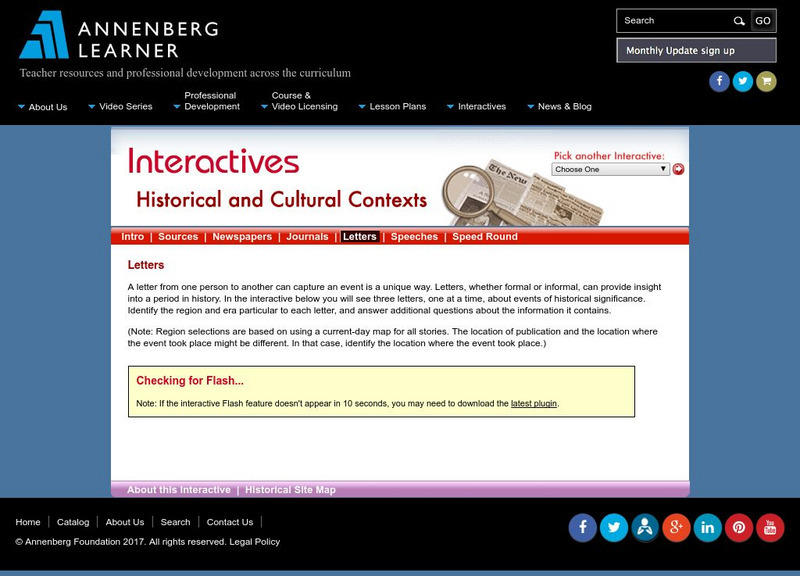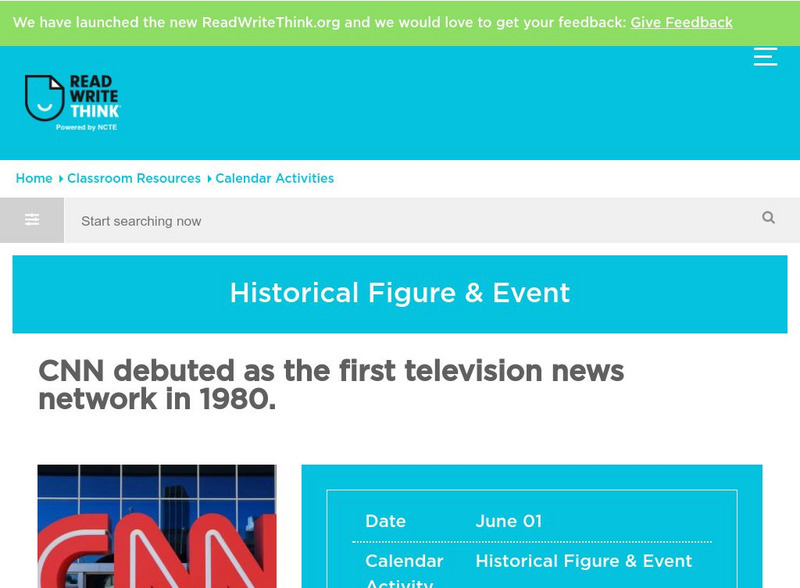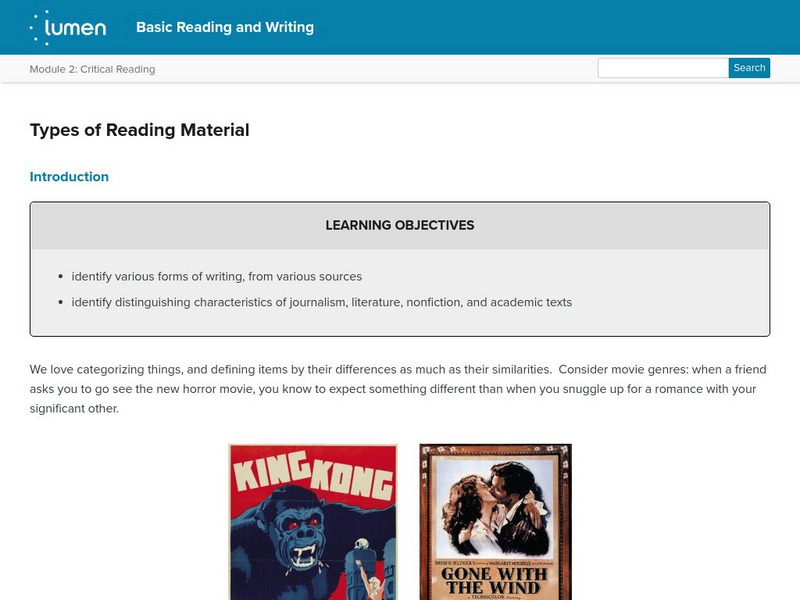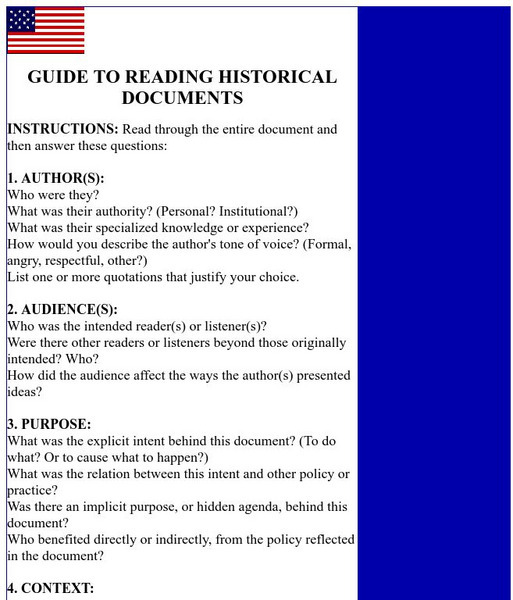University of Iowa
University of Iowa Libraries: The Atlas of Early Printing
View this interactive reference tool to learn about the history of printing in Europe during the fifteenth century. Features a map that displays layers of information that can be viewed together or individually along with a timeline of...
Other
The Dbq Project
Teach students how to read with understanding, think straight, and write clearly using document-based questions.
Annenberg Foundation
Annenberg Learner: Letters: Use Your Document Detective Skills
Read three letters, one at a time, about events of historical significance. Identify the region and era particular to each letter, and answer additional questions about the information it contains.
ReadWriteThink
Read Write Think: Cnn Debuted as the First Television News Network in 1980
These lesson plans relate to the gathering and production of news and creating a visual timeline. There are links to other lesson plan ideas, as well as web links, and a brief bibliography. SL.11-12.2 Eval&Integrate sources
21st Century Schools
21st Century Schools: Critical Viewing Skills and Media Literacy
Understand media literacy as it relates to a student's ability to analyze, evaluate, critique and produce multiple media messages. Information and links to inspire students, teachers and all those who work with young people regarding...
University of California
History Project: Process of Historical Investigation [Pdf]
Outlines the process of historical investigation for students by teaching them the steps of research, analyzing evidence, and making interpretations.
Other
Nova Southeastern Univ: Research Paradigms and Meaning Making: A Primer [Pdf]
This paper is intended as an introduction to research methodology and how scientists construct meaning from a qualitative data analysis. (Published 2005)
Scholastic
Scholastic Teaching Resources: Informational Reading Response [Pdf]
This graphic organizer can be used with students when they read informational text. Students will write three facts they learned, two questions they still have after reading, and one interesting fact that they want to share.
Texas Education Agency
Texas Gateway: Compare Narrative and Informational Texts: Practice 1
Evaluate changes in audience, purpose, and tone in two different texts.
Lumen Learning
Lumen: Critical Reading: Types of Reading Material
This lesson focuses on the types of reading material and their distinguishing features. It also included two videos including the key features from a newspaper story video and a video that defines scholarly articles.
Huntington Library
Huntington Library: Using Primary Sources in the Classroom [Pdf]
This lesson provides guidelines for teaching students how to use primary sources such as images, text, or statistics (e.g., maps, census). Includes a document analysis worksheet.
Texas Education Agency
Texas Gateway: Compare Narrative and Informational Texts: Practice 1
[Accessible by TX Educators. Free Registration/Login Required] In this lesson, you are going to analyze differences in texts that use visual techniques to present narrative and informational content. You will also look at how information...
Other
Library of Congress: Teaching With Primary Sources
This website is an excellent resource for teaching with primary sources. This resource features Holocaust lessons, lesson plan strategies, and podcasts.
Science Struck
Science Struck: Understanding Linguistic Relativity Hypothesis
The principle of linguistic relativity looks at the connection between language and thought processes. This resource provides an explanation of linguistic relativity, its historical context, different types of research approaches, how it...
US National Archives
Nara: Teaching With Documents: Teaching With Documents
Site from National Archives provides copies of primary documents that can be used while presenting various topics in U.S. history.
Roy Rosenzweig Center for History and New Media
Teaching History: Interactive Historical Thinking Poster (Secondary)
This is an interactive historical thinking poster. History is an argument about the past. Constructing a narrative about history involves several tasks: Analyzing Primary Sources, Examining Source Information,Using Evidence to Support...
National Endowment for the Humanities
Neh: Edsit Ement: I'm Gonna Sit Right Down and Write Someone a Letter
Through the vast online resources available from EDSITEment, students can read the correspondence of the famous, the infamous and the ordinary, some of whom lived through extraordinary times. Use these fascinating letters as a starting...
Schools of California Online Resources for Education
Score: Guide to Reading Historical Documents
Here are some questions that serve as a guide while you read and study historical documents. The information at this website was originally written by the National Council for the Social Studies. W.11-12.9b US Doc Analysis
CommonLit
Common Lit: Units: 9th Grade Thematic Unit: Education
Complete teaching unit for 9th Grade Thematic Unit: "Education." Students will read six informational texts focusing on the essential question: "How can education be used to create change?" They will gather information from their...
CommonLit
Common Lit: Units: 9th Grade Thematic Unit: Love
Complete teaching unit for 9th Grade Thematic Unit: "Love." In this unit, 9th graders will read six texts that speak to the theme of love. They will revisit the essential question "What is love, and how does it change us?" throughout the...
CommonLit
Common Lit: Text Sets
This is a collection of 35 Grade-Leveled text sets (4-11). They are great for social studies teachers or for building background knowledge in reading class, CommonLit's text sets cover a range of historical, cultural, and political...
Other
Learning theories.com: Summaries of Learning Theories and Models
Lists many models and theories of learning. Each one links to the summary of an article. A paid subscription is necessary to access the full article. But if a definition or brief explanation of a term is needed, the summary should...
CommonLit
Common Lit: Themes: Education & Knowledge: What Is the Goal of Education?
This is a collection of Grade-Leveled texts (3-12) to address the question, "What is the goal of education?" Select a grade level and a collection of on grade-level reading passages on the topic comes up. [Free account registration...
Alabama Learning Exchange
Alex: Where Am I in Cyberspace?
This activity allows students to utilize critical thinking skills and Internet research to develop a technology timeline. The timeline will assist students in developing a word processed sample list of items for a time capsule, which can...





![Nova Southeastern Univ: Research Paradigms and Meaning Making: A Primer [Pdf] Article Nova Southeastern Univ: Research Paradigms and Meaning Making: A Primer [Pdf] Article](https://content.lessonplanet.com/knovation/original/246161-1f2c0ae29b4b63e74270daf9a6a5b49c.jpg?1661550329)
![Scholastic Teaching Resources: Informational Reading Response [Pdf] Graphic Scholastic Teaching Resources: Informational Reading Response [Pdf] Graphic](https://content.lessonplanet.com/knovation/original/261457-b11bd4d074a51abd27ef520fb690e45a.jpg?1661510812)






